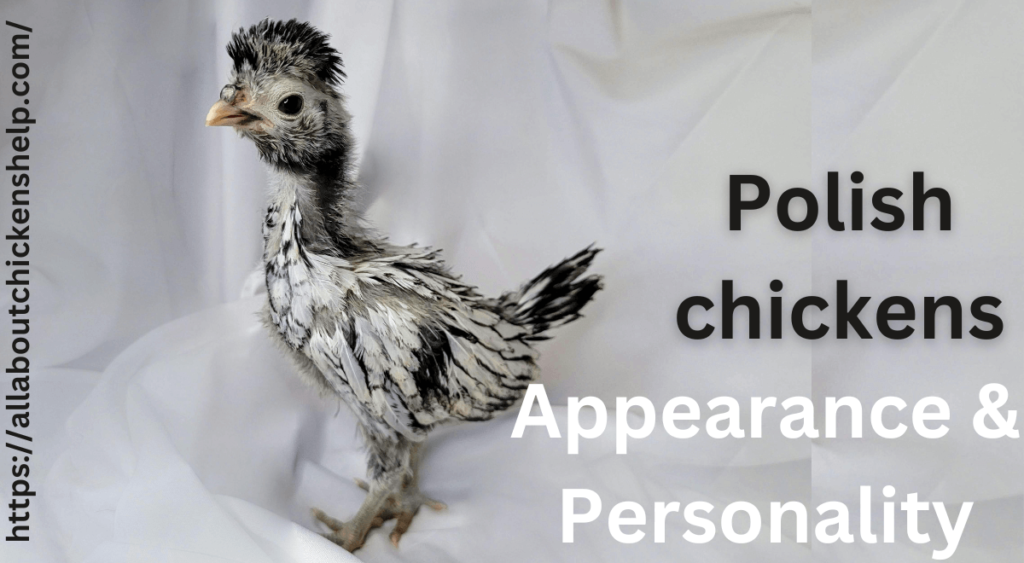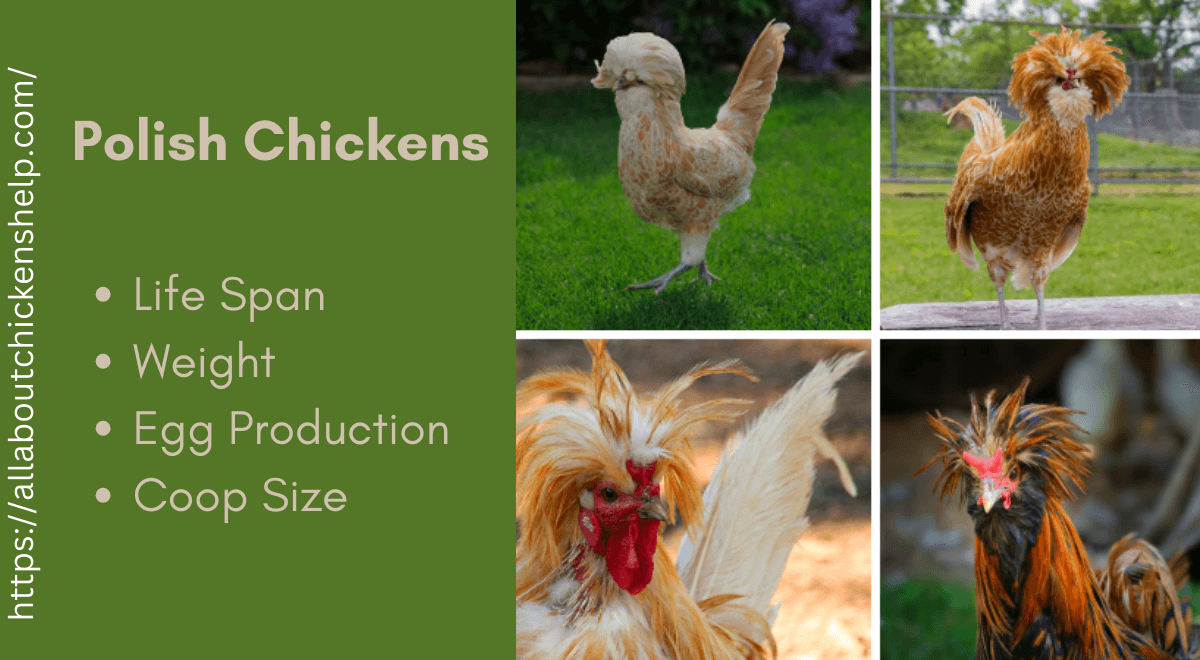Last Updated on 2 March 2024 by Anthony
Welcome to Polish chickens The ultimate Breed Guide are quirky, charming, and utterly unique. With their distinctive head feathers and storied history, they can quickly become the stars of your backyard chicken coop. In this comprehensive guide, we’ll explore everything you need to know about these fascinating birds.
Overview
- Lifespan: 7 to 8 years
- Weight: 4.5 to 6 pounds
- Appearance: Diverse Color Variations and Fluffy Head Plumage
- Egg Production: 3 to 4 eggs per week, totaling 150 to 200 per year
- Good for Beginners: Yes
- Recommended Coop Size: 4 Square Feet per Bird
- Price: $4 to $5 per chick (approx)
History of the Polish Chickens Breed
The origins of Polish chickens remain somewhat mysterious. One theory suggests that their ancestors were brought by Asian Mongols to Eastern and Central Europe during medieval times, possibly originating in Poland.
Another theory points to immigrants introducing the breed’s ancestors from Italy or Spain in the late 16th century. Regardless, the breed was standardized and recognized in the Netherlands, where it gained thoroughbred status.
Interestingly, paintings from the 1500-1700s depict chickens that resemble Polish chickens, emphasizing their historical significance.
The sophisticated Polish chickens were highly prized by the French aristocracy, so much so that they were chosen to accompany the dethroned King of Poland during his exile to France. Remarkably, he personally transported them within his luggage, showcasing their esteemed status even during turbulent political times.
Appearance and Personality
- They are known for their remarkable crest of feathers, which nearly covers their entire heads.
- Their large, fluffy head feathers give them a distinctive appearance.
- Despite their quirky looks, they have a peaceful demeanor.
The Role of Polish Chickens in Egg Laying and Meat Production
Polish chickens, with their distinctive appearance and charming personalities, are not only prized for ornamental purposes but also contribute to egg laying and meat production. While they may not be as prolific in egg production or meat yield as some commercial breeds, they offer unique qualities that make them valuable additions to backyard flocks and small-scale farming operations.
Egg Laying:
Polish chickens are moderate egg layers, producing a respectable number of eggs throughout the year. While individual egg production can vary depending on factors such as breed, age, and environmental conditions, Polish hens typically lay white or tinted eggs of medium size, producing 3 to 4 eggs per week (it may vary).
Although they may not match the egg-laying capacity of some hybrid or commercial breeds, they make up for it with the quality and beauty of their eggs. Their eggs are known for having strong shells and rich, flavorful yolks, making them prized by backyard chicken keepers and culinary enthusiasts alike.
When it comes to egg laying, Polish chickens require the same basic care as other laying hens. Providing a balanced diet, access to fresh water, comfortable nesting boxes, and a stress-free environment can help maximize their egg production and ensure the health and well-being of the flock.
Meat Production:
While Polish chickens are not typically bred for meat production on a commercial scale, they can still be used for meat in backyard or small-scale farming settings. They have a fine-textured and flavorful meat, making them suitable for culinary purposes.
When raising them for meat, it’s essential to consider factors such as breed, age at processing, and overall meat quality. While they may not yield as much meat as larger, dual-purpose breeds, they can still provide a delicious and satisfying protein source for home-cooked meals.
For those interested in raising Polish chickens for meat, it’s crucial to provide them with proper nutrition, ample space to roam and forage, and humane treatment throughout their lives. Additionally, selecting birds with desirable meat traits and processing them at the appropriate age can help ensure a flavorful and enjoyable meat product.

Breeding and Health Considerations for Polish Chickens
Polish chickens, renowned for their striking appearance and charming personalities, are a favorite among poultry enthusiasts worldwide. Whether kept for aesthetic purposes, egg production, or simply as backyard companions, breeding and maintaining the health requires careful consideration and attention to detail.
Breeding Polish Chickens:
Breeding Polish chickens involves selecting birds with desirable traits and characteristics to perpetuate and improve the breed. Considerations for breeding include:
- Breed Standards: Familiarize yourself with the breed standards for Polish chickens, which outline ideal characteristics such as crest size and shape, plumage color, and overall conformation. Breeding towards these standards helps maintain the integrity of the breed.
- Selecting Breeding Stock: Choose breeding stock with strong genetic traits, including robust health, good temperament, and adherence to breed standards. Look for birds with well-formed crests, glossy plumage, and vitality.
- Avoiding Inbreeding: Preventing inbreeding is crucial for maintaining genetic diversity and reducing the risk of genetic abnormalities. Rotate breeding pairs and introduce new bloodlines periodically to avoid potential issues.
- Record Keeping: Keep detailed records of breeding pairs, hatch dates, and offspring characteristics. This information helps track lineage, identify breeding trends, and make informed breeding decisions.
- Culling: Be prepared to cull birds that do not meet breed standards or exhibit health issues. Culling ensures that only the strongest and healthiest individuals are used for breeding, thereby improving overall flock quality.
Health Considerations for Polish Chickens:
Maintaining the health of Polish chickens is essential for their well-being and productivity. Key health considerations include:
- Preventive Care: Implement a proactive health care regimen that includes regular vaccinations, parasite control, and sanitation practices. Preventive measures help minimize the risk of disease and maintain flock health.
- Disease Management: Monitor Polish chickens for signs of illness, such as lethargy, decreased appetite, or abnormal behavior. Promptly isolate and treat sick birds to prevent the spread of disease within the flock.
- Nutrition: Provide Polish chickens with a balanced diet consisting of high-quality poultry feed supplemented with fresh fruits, vegetables, and occasional treats. Ensure access to clean, fresh water at all times to support overall health and vitality.
- Environmental Considerations: Maintain a clean and well-ventilated coop environment to reduce the risk of respiratory issues and parasitic infestations. Provide adequate space for exercise and foraging to promote physical and mental well-being.
- Stress Management: Minimize stressors such as overcrowding, extreme temperatures, and predator threats, as stress can weaken the immune system and make chickens more susceptible to illness.
By prioritizing breeding practices that uphold breed standards and promote genetic diversity, as well as implementing proactive health care measures, poultry enthusiasts can ensure the longevity, vitality, and well-being of their Polish chicken flocks. With proper care and attention, Polish chickens will continue to enchant and delight their keepers for generations to come.
Ideal Environment and Care
Certainly! Here’s a table outlining the ideal environment and care for Polish chickens:
| Aspect | Description |
|---|---|
| Housing | Provide a spacious and well-ventilated coop with protection from predators and the elements. |
| Ensure adequate roosting space and nesting boxes for each chicken. Provide a minimum of 4 square feet per bird in the coop. Ensure a safe and comfortable environment for their unique head feathers. | |
| Feeding | Offer a balanced diet of commercial poultry feed supplemented with fresh fruits and vegetables. |
| Provide access to clean, fresh water at all times. | |
| Health and Hygiene | Implement regular parasite control and vaccination schedules. |
| Maintain cleanliness in the coop by regularly removing droppings and replacing bedding. | |
| Social Interaction | Allow for socialization within the flock to prevent stress and promote natural behaviors. |
| Handle chickens gently to build trust and minimize fear. | |
| Environmental Enrichment | Provide opportunities for foraging, dust bathing, and exploring in a safe outdoor space. |
| Offer environmental enrichment such as perches, branches, and toys for mental stimulation. |
This table outlines key aspects of providing an ideal environment and care for Polish chickens, ensuring their health, well-being, and happiness.
Benefits and Challenges of Keeping Polish Chickens:
Polish chickens, with their distinctive head feathers and historical significance, are captivating additions to any backyard flock. Let’s delve into the benefits and challenges of raising these unique birds:
Benefits:
Unique Appearance: Polish chickens’ large, fluffy head crests make them stand out in any coop. Their quirky appearance adds charm and personality to your flock.
Good Egg Production: Despite their whimsical looks, Polish hens are reliable egg layers. They typically produce 3 to 4 eggs per week, contributing to your breakfast table.
Peaceful Temperament: Polish chickens are known for their gentle and friendly personalities, making them ideal companions for backyard enthusiasts of all ages. They are often docile and easy to handle, making them suitable for families with children or those looking for feathered friends to interact with. Their gentle nature makes them suitable for families and beginners.
Challenges:
Crest Maintenance: The most distinctive feature of Polish chickens—their head crests—requires regular attention. Crests can become dirty, tangled, or matted, necessitating careful grooming.
Susceptibility to Dirt and Tangles: Due to their large crests, Polish chickens are prone to getting debris and dirt trapped in their feathers. Regular checks and cleaning are essential to keep their crests in good condition.
Limited Meat Production: While Polish chickens are primarily kept for ornamental purposes and egg production, they are not ideal for meat. Their small size and unique appearance make them less suitable for meat production.
Conclusion:
Polish chickens aren’t just birds you keep around—they’re like living time capsules, carrying a piece of history with them. If you like how different they are and are okay with spending some extra time taking care of their fancy feathers, these cute little guys can make your backyard a whole lot more interesting. Whether you’ve been taking care of chickens for a while or you’re just starting out, thinking about getting some Polish chickens for your flock could be a really fun idea!
Frequently Asked Questions about Polish Chickens
Do Polish chickens breed true?
Polish chickens do not breed true. Their offspring can exhibit a range of variations in appearance, including differences in crest size and color. This lack of consistency is due to the genetics involved in their unique crests. If you’re specifically aiming for certain traits, careful breeding selection is necessary.
How long do Polish chickens take to hatch?
Polish chicken eggs usually take around 19 to 21 days to hatch.
What is the use of the Polish chicken breed?
Polish chickens are primarily valued for their ornamental beauty, as they have striking appearances with elaborate crests of feathers. Additionally, they contribute to egg production, albeit at a moderate rate, and are cherished as friendly companions in backyard settings.
At what age do Polish chickens start laying?
Polish chickens generally start laying eggs at 5 to 7 months old.
How many eggs do Polish chickens produce?
Polish chickens typically lay around 150 to 200 eggs per year.
What color eggs do Polish hens lay?
Polish hens typically lay white or tinted eggs.


